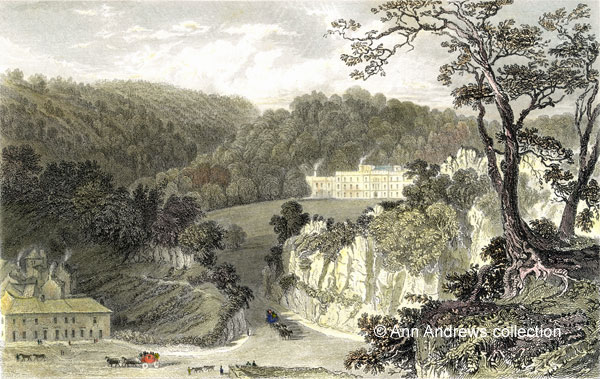WILLERSLEY CASTLE, DERBYSHIRE
From original drawing by Thomas Allom.
Published in "The Counties of Chester, Derby, Leicester, Lincoln, and Rutland, Illustrated"..
The following text accompanied the engraving and is almost the same as the description published in "Beauties" linked below:
"Willersley Castle, the beautiful mansion of Richard Arkwright, esq., stands on the south side of a commanding eminence, which runs from east to west,
and terminates the extensive range of rock that forms the eastern boundary of the Derwent, in its course through Matlock Dale. At the foot of the hill,
the river flows in a grand sweep towards the east ; but afterwards resumes its way to the south, and traverses a more open country."
"Immediately in front of the castle rises a lofty perpendicular rock, forming the western extremity of the dale, and through which a passage has
been blasted, to admit an entrance of the road from the south. Hence the building is seen to very great advantage ; its castellated appearance, judicious
proportions, exact symmetry, and beautiful surrounding scenery, forming a coup d'oeil rarely witnessed."
"The castle consists of an oblong square, with a low circular tower rising from the centre of the roof, and a semicircular turret projecting from the
front on each side of the entrance; and two wings have a rounded tower at each entrance. A singular circumstance, connected with its erection, and one highly
characteristic of the gifted individual by whom it was raised, is — that the spot, on which it stands, was originally occupied by a vast rock, that
required great effort in its removal, which was effected at an expense of no less than three thousand pounds. The architect was Mr. W. Thomas, of London ;
but there is reason to believe that his portion of the design was confined to technicalities only, and that Sir Richard Arkwright himself had arranged
the whole economy of the building in his mind. An accident occurred to the edifice while the interior was finishing, in consequence of a stove being overheated,
and all that was combustible was destroyed. This, however, only retarded completion."
The hillside on the left of the new entrance into Matlock Bath rises up to Harp Edge, with some of the buildings on the edge of Cromford Market Place and in
Scarthin visible behind the row of buildings on the left edge of the engraving.
Ebenezer Rhodes had passed through here on his last excursion into Derbyshire in the early 1820s: "We quited Matlock with regret — passed through the
artificial opening that has been made in Scarthing Rock — left the greyhound-inn at Cromford on our right — and entered into a deep but narrow Dale
that leads to Bonsal and Via Gellia[1]." He and his companion were on foot.
This excellent view of Willersley includes two closed coaches, each pulled by four horses; such vehicles were known as a 'coach and four' and were driven by a
coachman seated on the box. There were passengers inside each coach, and more were sitted on top, facing both forwards and backwards. Not a place to be in heavy
downpours! The left hand coach was possibly heading for the Greyhound Hotel (see Scarthin Nick From Allen's Hill, 1892). It is
possible that the two pairs of horses that are being led were going to the Greyhound to provide fresh horses for the onward journey.
 A description of Sir Richard Arkwright's
funeral by J. P. Malcolm was published in "The Gentleman's Magazine" in 1793 (scroll down
to Matlock, pp.45-6). A description of Sir Richard Arkwright's
funeral by J. P. Malcolm was published in "The Gentleman's Magazine" in 1793 (scroll down
to Matlock, pp.45-6).
We see a somewhat different view of Willersley Castle in the engravings below, published in "The Beauties of England and Wales",
1802. The house had been finished by then.
 Willersley Castle : Seat of Richard Arkwright, Esq Willersley Castle : Seat of Richard Arkwright, Esq
 Cotton manufacture, Willersley &
Sir Richard Arkwright Cotton manufacture, Willersley &
Sir Richard Arkwright
Also of interest is:
 Cromford,
about 1773. Cromford,
about 1773.
|
| References:
[1] Rhodes, Ebenezer (1824) "Peak Scenery" pub. London, Longman, Hurst, Rees, Orme, Brown,
and Green, Paternoster Row.
|







 A description of Sir Richard Arkwright's
funeral by J. P. Malcolm was published in
A description of Sir Richard Arkwright's
funeral by J. P. Malcolm was published in  Willersley Castle : Seat of Richard Arkwright, Esq
Willersley Castle : Seat of Richard Arkwright, Esq